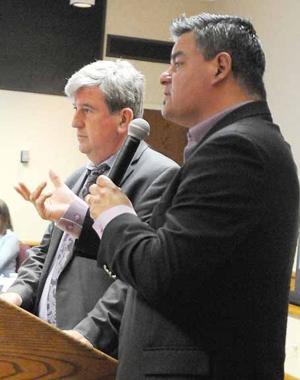Minister to visit Grassy Narrows
Study coming soon
Glen Murray, Minister of the Environment and Climate Change, left, and Ontario Regional Chief Isadore Day met with representatives from 15 First Nations across the province to discuss climate change policies during a two-day conference at the Valhalla Inn in Thunder Bay.
A study looking to find a possible source to the mercury contaminating the water sources of Grass Narrows First Nation is expected to get underway this month.
Ontario Minister of the Environment and Climate Change Glen Murray was in Thunder Bay on Tuesday for a two-conference at the Valhalla Inn. He was joined by Ontario Regional Chief Isadore Day and fellow Minister of Northern Development and Mines Michael Gravelle.
The conference intends to explore new climate change policies and discuss them with representatives of 15 Ontario First Nations communities and the province.
Murray revealed more information on the efforts to help out the community of Grassy Narrows.
The First Nation community has been dealing with mercury-contaminating Wabigoon River and Clay Lake for decades. About 9,000 kilograms of mercury leaked into the river from a Dryden-area paper mill more than 40 years ago.
Murray said they looked at a report that stated there might be new technologies to remove the mercury from the river and the lake but it’s not quite that simple.
“Could it (the mercury) be removed without disturbing it,” he said.
“Because the potential to make this a lot worse is there. That’s part of the problem with mercury — and would those technologies be appropriate? Would they work?”
Murray said they have committed to do a major field study of the area that will be starting “right away” and will continue into 2017.
The field study will look at the sediment, check for a secondary source of mercury, test the condition of the mercury that’s in the sediment in the lake and determine where is it located.
“There’s a work group with the federal government that will work under the leadership of the First Nation,” said Murray. “The work will be done through and under the supervision of that working group and will be underway this month and I’ll be going there in a couple of weeks.”
Day argued that First Nations have contributed the least amount to greenhouse gasses and emissions but their communities — especially those found in the remote north — are already feeling the effects of climate change.
This includes disrupted access to fish and wildlife, lack of winter roads, extreme weather and natural disasters.
Day said climate change is a matter of life and death for indigenous people.
“We need to work together closely, get through grievances and the hard history,” he said.
“Climate change is moving fast. It’s moving faster. I think it’s really important for us to underscore the importance of making sure that we have the resources, that we have the space at the table and that our decisions and input is well respected. We are going to need to make sure that our young people, our experts, our elders, our women are part of that process and it needs to happen yesterday.”
Day said he attended the conference to promote an overall joint policy approach — a climate change framework — with First Nations and the Ontario Government. He explained that it will be multifaceted and although he expects it will be a complex process, it has to be done.
Earlier this month, the province announced its climate change action plan, which aims to tackle environmental issues while reducing greenhouse gas pollution.
Day put his support in the plan and said he thinks all the pieces are there while adding the province has laid out broad targets.
“Now we need to tailor the relationship with Ontario and that’s the work we’ll be doing over the next several months,” he added.





